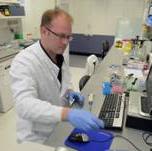
Contact information
Alistair Pagnamenta
Post-doctoral researcher
Work summary
Since joining the Oxford BRC in 2010, I‘ve been involved with a wide range of studies ranging from learning disability to pharmacogenomics. I have been in the sequencing and experimental follow-up team for the WGS500 project and subsequently a data analyst for a clinical exome sequencing project and ongoing HICF2 WGS sequencing programme [hyperlinks?]. More recently I have been involved with analysis of data generated as part of the 100K genomes project as part of the paediatric and musculoskeletal GeCIPs.
Current interests include the genetics of epilepsy and structural brain malformations, de novo mutations in adolescent schizophrenia and the GPI anchor biosynthesis pathway. A significant proportion of our work relates to uncovering causative mutations using NGS analysis of either i) parent-parent-child trios or ii) consanguineous families. Recent studies using these methods helped uncover PGAP3 as a new disease gene for learning disability and hyperphosphatasia and a collaboration with the DDD project showed more broadly that GPI-anchor biogenesis defects are a rare cause of developmental disorder. Other interests include the analysis of structural variation using NGS data, UPD and genetic mosaicism. Previously I worked on autism genetics with Professor Anthony Monaco and on mitochondrial disorders with Dr Jan-Willem Taanman and Dr Shamima Rahman.
Recent publications
-
A syndromic neurodevelopmental disorder caused by rare variants in PPFIA3.
Journal article
Paul MS. et al, (2024), American journal of human genetics, 111
-
Reticulon 2 deficiency results in an autosomal recessive distal motor neuropathy with lower limb spasticity.
Journal article
Maroofian R. et al, (2024), Brain
-
Biallelic NAA60 variants with impaired n-terminal acetylation capacity cause autosomal recessive primary familial brain calcifications.
Journal article
Chelban V. et al, (2024), Nat Commun, 15
-
Biallelic NUDT2 variants defective in mRNA decapping cause a neurodevelopmental disease.
Journal article
Husain RA. et al, (2023), Brain : a journal of neurology
-
Structural and non-coding variants increase the diagnostic yield of clinical whole genome sequencing for rare diseases.
Journal article
Pagnamenta AT. et al, (2023), Genome medicine, 15

